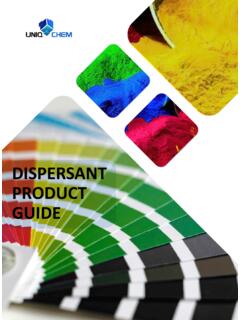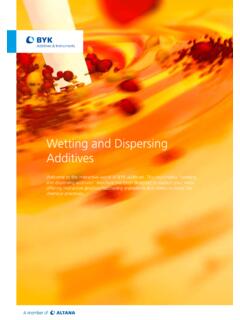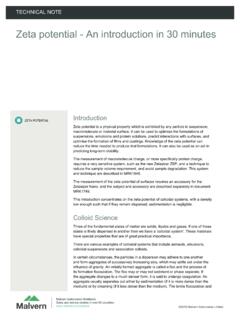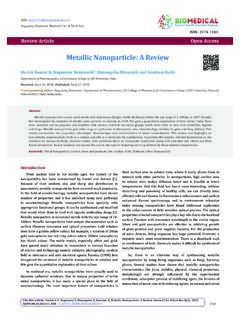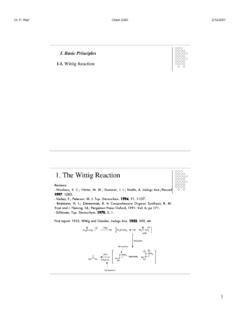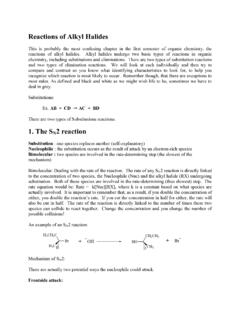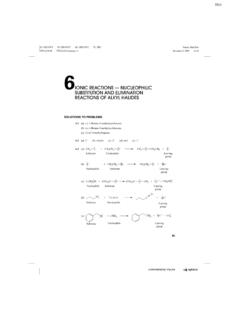Transcription of Surfactants – classification, features and applications
1 Surfactants classification, features and applicationsSurfactants classification, features and applicationsN. D. Denkovand S. TcholakovaDepartment of Chemical Engineering,Faculty of Chemistry, Sofia University, Sofia, BulgariaLecture at COST P21 Training School Physics of droplets: Basic and advanced topics Borovets, Bulgaria, 12 13 July, 20101. Classification of Particles as foam and emulsion Role of Surfactants for various foam and emulsion properties:(a) Thin film drainage and stability(b) Foam rheology(c) Foam drainage(d) Ostwald ripening4. Current Low molecular mass Surfactants 9 Nonionic 9 Ionic9 Amphoteric Polymeric surfactants9 Synthetic9 Natural Particles as surfactant species9 Spherical vs.
2 Non-spherical9 Hydrophilic vs. hydrophobic1. Classification of surfactantsLow-molecular mass surfactants1. Nonionic surfactantsAlkylpolyoxyethylenesCnEOmTwe ensSpans2. Ionic surfactantsn=12 sodium dodecyl sulfate, SDS(a) AnionicDiffuse electric layer(b) Cationicn=12 dodecyl trimethyl ammonium chloride, DTAC3. Amphoteric Surfactants (b) Betaines(a) Natural soaps (alkylcarboxylates), LipidsStabilization of foam films by surfactantsBoth can be explained as a result of higher osmotic pressure in the foam filmElectrostatic stabilization by ionic surfactantsIonic surfactantsSteric stabilization by nonionic surfactantsNonionic surfactantsRole of surfactant micellesSolution rheology(shampoos, dish-washing gels)higher solution viscosityStructural forcesin foam films:Control of micelle shape.
3 Mixtures (SLES+CAPB), counterions (Ca2+), temperature (for EO Surfactants )Comparisonof the low-molecular mass surfactantsMixtures are usually used in applications (main surfactant + cosurfactant polymers)*Adsorption, surface tension, CMC, micelle size and shape, foam and emulsion stability Sensitivity* NonionicIonic Amphoteric Electrolytes NO YES Depends on pH Temperature YES NO NO pH NO NO YES Hydrophile Lipophile Balance (HLB)C16H33(C2H4O)20 OHHLB =20*M(hydrophilic) / M(surfactant) ExampleBrij 58 = Polyoxyethylene-20 hexadecyl ether M(hydrophylic) =20*44=880M(surfactant) = 1120 HLB = (880*20)/1120 = between HLB and surfactant applicationsHLB < 8 HLB > 10 Mixing unlike oils together Surfactants with HLB s of 1 to 3 Preparing water-in-oilemulsions Surfactants with HLB s of 4 to 6 Preparing self emulsifying oils Surfactants with HLB s of 7 to 10 Preparing oil-in-wateremulsions surfactant blends with HLB s of 8 to16 Detergent solutions Surfactants with HLB of 13 to 15 Solubilization of oil into water (microemulsion) surfactant blends with HLB of 13 to 18 Polymeric surfactants1.
4 Synthetic polymers(a) HomopolymersPolyvinyl alcohol, PVAM odified polysacharides(b) Block-copolymersSynperonics, EOnPOmEOn2. Natural polymers(proteins)(b) Fibrilar -casein -casein(a) GlobularBovine serum albumin, BSA -lactoglobulin, BLGVery often mixtures of proteins + polysaccharides are used in applicationsModes of foam stabilizationby polymeric surfactantsUsually: combination of steric + electrostatic stabilizationSynthetic polymersNatural polymers1. Types of Solid particles(a) Mineral -SiO2, Ore particles(b) Polymeric - latex2. Particle monolayersParticle adsorption energy = R2 (1-cos )2 >> kBT 2. Particles as surfactant speciesMain factors: Particle hydrophobicity Particle size Particle shapeParticle stabilized emulsions and foamsOilparticlesDinsmore et al.
5 , Science, 2002 Particle layer on drop surfaceStabilization of films by capillary forcesRelatively thick foam films that are very stable, if the particle layers are completeProblems with particle stabilized foams Strong capillary attraction between particles Creation of weak spots (free of particles) in the films!Velikov et al., Langmuir, 1998 Lateral capillary forcesqL0123402468101212 FqQQ Role of particle shape Foam super- stabilization by polymer microrods Alargova et al., Langmuir 20 (2004) particles seem to be a better option for foam stabilizationRole of particle aggregationSurface aggregationBulk aggregationAntifoam effectof hydrophobic particlesAntifoam effectof hydrophobic particlesAntifoam effectTECHNOLOGY Pulp and paper production Oil industry (non-aqueous foams) Fermentation Textile colouring Powders for washing machines Paints DrugsCONSUMER PRODUCTSC omposition of Typical Antifoams2.
6 Oil Silicone oils (PDMS) Hydrocarbons (mineral oil, aliphatic oils)Silica particlesEmulsified oil 100 nm30 m Silica (SiO2) Polymeric particles3. Compound Oil + particlesCompoundglobule 30 m1. Hydrophobic solid particles Film rupture by solid particlesbridging-dewetting mechanismKey factors:(1) Particle contact angle(2) Particle size and shape90>o 45 >o3. Role of Surfactants forvarious foam and emulsion properties3. Role of Surfactants forvarious foam and emulsion propertiesFoam film drainage and thicknessAnionic surfactant, SDSS peed: 1 Polymeric surfactant, PVAS peed: 4 Protein,Na caseinateSpeed: 8hEQ 10 nm DR 60 sechEQ 120 nm DR 300 sechEQ 30 nm DR 600 secLarge vertical filmsSLES+CAPB real timeSLES+CAPB+MAcaccelerated 5 timesMuch slower film drainage in MAc-containing systemDifferent mode of film drainage - no marginal regenerationFoam rheologyFoam rheology1.
7 Viscous friction in flowing Role of surface modulus (surfactant dependent).3. Bubble V& Effect of surfactant typeCapillary number, Ca10-710-610-510-410-310-2 Dimensionless viscous stress10-310-210-1100 SoapAnionic+CTAC+LOH+LAc+MAc+PAc+MAc/PAc Anionic+ 6 othercosurfactantsTheoreticalcurven RCa = &Capillary numberV32 VR = %Dimensionless viscous stress()()0sinStSSt = ()()0sintt = + Oscillating drop0cosSTGS = Storage modulus0sinLSGS = Loss modulusS0 + S0 < 0 > 0 Role of surface modulus S/S0, %10-1100101GD, mN/m100101102103 = HzT= 25 CExperimental results for surface modulus()1222 DSTLSGGG=+Soap solutions: GD > 100 mN/mCAPB, SDS, SLES.
8 GD < 5 mN/mAnionicSoapTotal modulusMechanisms of energy dissipation in sheared foamFriction in foam filmsS0S0+ SS0 Surface % Denkov et al., PRL, 2008; Soft Matter 2009; Tcholakova et al., PRE, % = number, Ca10-710-610-510-410-310-2 Dimensionless viscous stress10-410-310-210-1 Hexadecane, D = 3 oil, D = 30 oil, D = 150 , EO20n= good description without any adjustable parameterComparison with experimental datafor emulsionsCapillary number, Ca10-610-510-410-3 WR32/ 10-310-210-1 SyntheticsurfactantsSoap0nWkV =n= 2/3n= 1/2 SoapCAPB0 to 70 % Glycerol0 VCa = 32WR = %Capillary numberDimensionless wall stressLower friction for CAPB compared to soap surfactantsFoam-wall frictionV0 Initial foamR32= 730 mFinal foamR32= 230 mconst =&Bubble breakup in a rheometerShear stress as a function of time.
9 =&const1~nR At Bubble (drop) breakup in sheared foams (emulsions)Time, sec0306090120150180 Shear stress, Pa10152025303540 AnionicR32 = 480 mR32 = 220 mAnionic+ wt % MAcSmaller and less polydisperse bubbles are formed at high surface modulus = =&AnionicAnionic+MAcBubble breakup in steadily sheared foamFoam drainageSurface stress in foam drainageHigh surface modulusLow surface modulusLongitudinal section of the Plateau channel()===00 SZVVx() = = =00 SVxTime, sec050010001500200025003000(R(t)/R0) +LAcAnionic+MAcMuch slower bubble coarsening in FAc-containing systemp1, V1p2, V2 FoamOstwald ripening in foams, R32(t) Effect of Surfactants on film permeability(Princen & Mason, 1965) C2(p2)C1(p1)C1IC2Ih2 MLDHkhDk=+D diffusion coefficienth thickness of the filmH Henry constantkML monolayer permeability ()122 FMLdnDHACCdthDk= +Arrest of Ostwald ripening by solid particlesP1> P2Xu et al.
10 , Langmuir, 2005P1= P2 applications :Ice-cream, whipped cream, chocolate mousse, ..P2P1P1> P2 SummarySurfactants with high surface modulus:Fatty acids, fatty alcohols and acids as cosurfactants, .. Surfactants with low surface modulus(anionic, cationic, nonionic; HLB concept; ..):SDS, SLES, CAPB, CTAC, EO7, ..Particles(in combination) give new options:Arrest of Ostwald ripening, different rheology, ..Mixtures are often preferred in applications :SDS+LaOH, DTAB+LaOH, SLES+CAPB, CAPB+FAc, LAS+EO7, ..Surfactant + Polymer, Surfactant + ParticlesCurrent activityCurrent activity Biosurfactants: Polymers-surfactant mixtures.
